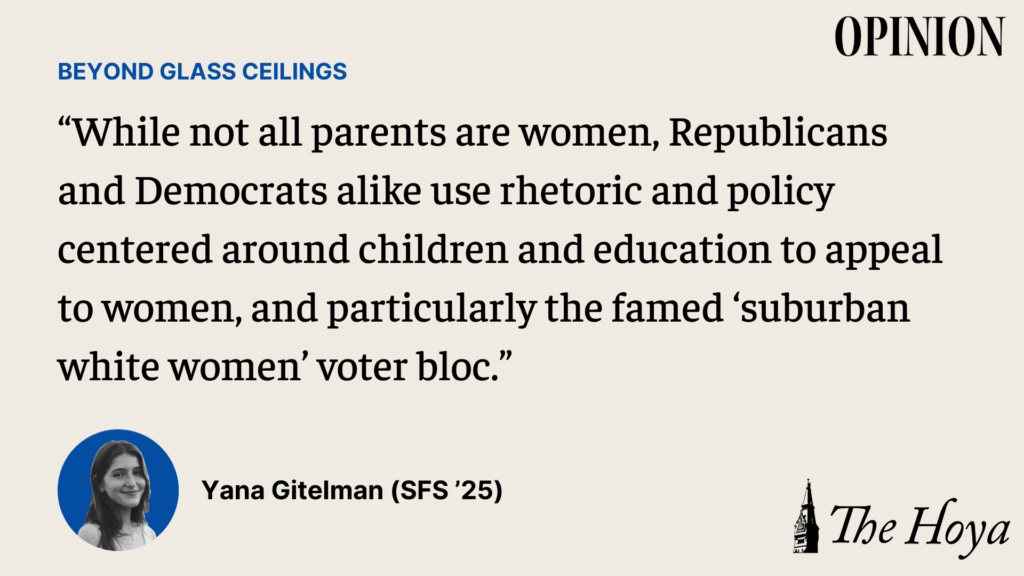In Virginia’s 2021 gubernatorial election, Republican Glenn Youngkin beat Democrat and former governor Terry McAuliffe. Youngkin also won more of the white women’s vote in Virginia than former President Donald Trump in 2020; 57% of Virginia white women voted Republican in 2021, as opposed to 49% in 2020. White women swung 13% more Republican overall, and non-college-educated white women swung 37%.
Youngkin advocated for “parents’ rights,” namely the right of white suburban voters to prevent their children from learning about America’s complete racial history. In a televised interview, Youngkin vowed to ban critical race theory on his very first day in office. Exit polls found that 25% of Virginia voters cited “critical race theory” as their top reason for voting right, while 72% said it was “important.”
While not all parents are women, Republicans and Democrats alike use rhetoric and policy centered around children and education to appeal to women, and particularly the famed “suburban white women” voter bloc.
The social positioning of white women like myself allows us more room to choose between our identities. While gender-based violence affects all people of marginalized genders, it affects women and nonbinary people of color disproportionately. And where white women experience violence, it is generally more likely that our voices will be heard and believed. When it works to our benefit, we can — to some extent — choose to put aside our gender and focus on our race. More precisely, our gender and race combine; the concerned white mother has always played a forceful role in American politics, from the Women’s Praying Crusade to the Parents Music Resource Center to Moms Demand Action.
White femininity equips white women with a unique political capital. We are stereotyped as needing protection, while women of color are often seen as threatening. The concerned white mother tends to conjure concern and sympathy even in the men who look down on her. The infantilization of white women, while inarguably misogynistic, is far less dangerous than manifestations of misogyny against women of color, such as the adultification of Black women.
A majority of Virginia’s white women decided to vote not as marginalized women, but as mothers concerned about their children being exposed to critical race theory, not solely because they were manipulated by Youngkin, but because of their own identities, fears and belief systems.
Trying to “win back” suburban white women must not mean giving the benefit of the doubt to white voters whose political actions result in the active harm of people of color. Compromising functional progressive policies to cater to these voters’ racially motivated emotional responses jeopardizes the well-being of marginalized voters.
In political discourse, we must seek to understand and empathize with all voters if we want to create and maintain a functional democracy. True understanding, however, does not look like infantilization. It requires an honest understanding of voters’ responsibility for the ways they vote. In “Caste: The Origins of Our Discontents,” Isabel Wilkerson examines the popular notion that white working-class voters vote against their interests by voting for Republican candidates. She makes the argument that actually, white voters swinging to the right are voting in their long-term interest of maintaining structural power within a white supremacist system. White working-class voters can set aside their economic need for health care in favor of the knowledge that they can sit toward the bottom of the class hierarchy and remain at the top of the dominant racial hierarchy.
In a representative governmental system, politics is much more about the voters than those in office. Youngkin’s manipulation of white women’s fears would have no foothold without the existence of those fears, which far predate his campaign. He did not single-handedly manipulate thousands of white women into voting for him; he tapped into centuries-old fears of the dissolution of white supremacy, under the guise of “parents’ rights.”
When we see a sweeping cultural trend, blaming politicians’ manipulation is not enough. Fearmongering and scapegoating by those in power can have powerful, dire consequences. But it requires something to latch onto, some preexisting fear or hatred that the powerful can bring to the surface. Those sentiments among the people outlast any individual public figure who exploits them.
Yana Gitelman is a first year in the School of Foreign Service. Beyond Glass Ceilings is published every other week.














